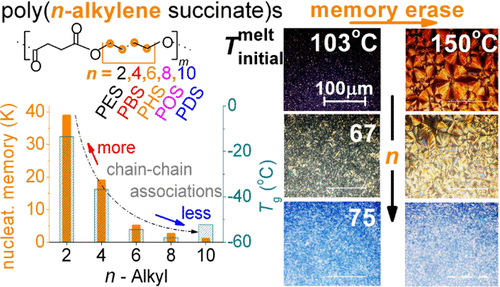当前位置:
X-MOL 学术
›
Macromolecules
›
论文详情
Our official English website, www.x-mol.net, welcomes your
feedback! (Note: you will need to create a separate account there.)
Synthesis, Crystallization, Structure Memory Effects, and Molecular Dynamics of Biobased and Renewable Poly(n-alkylene succinate)s with n from 2 to 10
Macromolecules ( IF 5.1 ) Pub Date : 2021-01-27 , DOI: 10.1021/acs.macromol.0c02109 Panagiotis A. Klonos 1, 2 , Lazaros Papadopoulos 2 , Maria Kasimatis 3 , Hermis Iatrou 3 , Apostolos Kyritsis 1 , Dimitrios N. Bikiaris 2
Macromolecules ( IF 5.1 ) Pub Date : 2021-01-27 , DOI: 10.1021/acs.macromol.0c02109 Panagiotis A. Klonos 1, 2 , Lazaros Papadopoulos 2 , Maria Kasimatis 3 , Hermis Iatrou 3 , Apostolos Kyritsis 1 , Dimitrios N. Bikiaris 2
Affiliation

|
In this article, we synthesize five poly(n-alkylene succinate)s, PnASs, with n = 2, 4, 6, 8, and 10 via multi-step polycondensation methods. Next, we comparatively investigate these renewable and biobased polyesters from the points of view of structure, crystallinity, and molecular mobility, employing 1H nuclear magnetic resonance spectroscopy, size-exclusion chromatography, viscometry, X-ray diffraction, differential scanning calorimetry (DSC, conventional and temperature modulation modes), polarized optical microscopy (POM), and broadband dielectric relaxation spectroscopy (BDS). Next to the successful synthesis of the materials, we evaluate the characteristics of crystallization (temperature and fraction); moreover, we explore for the first time, on the same type of succinic polyesters, the impact of n on the structure memory related to crystal nucleation as well as the changes in the semicrystalline morphology. We demonstrate that the structure/crystal memory is stronger for the lower n (shorter alkylene succinate monomers) because of more chain–chain associations, the result being independent from the overall length of the polymer chain (molar mass, Mn 13–80 kg/mass). The crystalline fraction (CF ∼ 12–34%) increases with n, also independently from Mn; however, the chain length affects directly the nucleation rate as Tc increases with Mn. The direct effects of n, in the inter-/intrachain interactions, as well as the indirect ones, on the CF and distribution of crystallites were found to be responsible for the alternations in the static glass transition temperature in DSC (lowering of Tg with n) and the dynamic glass transition (α, αc relaxations in BDS). For the sum of these PnASs, the molecular dynamics mapping is shown here, also for the first time. With increasing n, segmental dynamics accelerates, whereas, interestingly, the cooperativity drops (elimination for n = 10). Comparing these results with the recorded alternations in the semicrystalline morphology (POM), we conclude spatial confinement to be imposed on the mobile amorphous polymer by the tightly distributed crystallites when n increases. Overall, these data provide proofs for the potential for tuning of the final polymer properties connected with crystallization (mechanical performance and permeability), envisaging future biomedical, packaging, and other application for these PnASs.
中文翻译:

合成,结晶,结构记忆效应,以及生物基的分子动力学和再生聚(ñ -亚烷基琥珀酸酯)S采用Ñ 2至10
在本文中,我们通过多步缩聚方法合成了n = 2、4、6、8和10的5个聚(n-亚烷基琥珀酸酯)P n AS 。接下来,我们从结构,结晶度和分子迁移率的角度对这些可再生和生物基聚酯进行比较研究,采用1H核磁共振光谱法,尺寸排阻色谱法,粘度测定法,X射线衍射,差示扫描量热法(DSC,常规和温度调制模式),偏振光学显微镜(POM)和宽带介电弛豫光谱法(BDS)。在成功合成材料之后,我们评估结晶的特征(温度和馏分)。此外,我们首次探索了在相同类型的琥珀酸酯聚酯上,n对与晶体成核有关的结构记忆以及半结晶形态变化的影响。我们证明对于较低的n,结构/晶体记忆更强因为更多的链-链协会(短亚烷基琥珀酸酯的单体),结果是独立于聚合物链的总长度(分子量,中号Ñ 13-80千克/质量)。结晶分数(CF〜12–34%)随n的增加而增加,也独立于M n;然而,随着T c随着M n的增加,链长直接影响成核速率。发现n在链间/链间相互作用以及间接相互作用中对CF和微晶分布的直接影响是DSC静态玻璃化转变温度变化的原因(T g降低)与Ñ)和动态玻璃化转变(α,α- Ç松弛在BDS)。对于这些P n AS的总和,这也是第一次显示分子动力学图。随着n的增加,分段动力学加快,而有趣的是,协同性下降(n = 10时消除)。将这些结果与半结晶形态(POM)中记录的变化进行比较,我们得出结论,当n为0时,紧密分布的微晶将空间限制于可移动的非晶态聚合物增加。总体而言,这些数据为调整与结晶相关的最终聚合物性能(机械性能和渗透性)提供了证据,并为这些Pn AS设想了未来的生物医学,包装和其他应用。
更新日期:2021-02-09
中文翻译:

合成,结晶,结构记忆效应,以及生物基的分子动力学和再生聚(ñ -亚烷基琥珀酸酯)S采用Ñ 2至10
在本文中,我们通过多步缩聚方法合成了n = 2、4、6、8和10的5个聚(n-亚烷基琥珀酸酯)P n AS 。接下来,我们从结构,结晶度和分子迁移率的角度对这些可再生和生物基聚酯进行比较研究,采用1H核磁共振光谱法,尺寸排阻色谱法,粘度测定法,X射线衍射,差示扫描量热法(DSC,常规和温度调制模式),偏振光学显微镜(POM)和宽带介电弛豫光谱法(BDS)。在成功合成材料之后,我们评估结晶的特征(温度和馏分)。此外,我们首次探索了在相同类型的琥珀酸酯聚酯上,n对与晶体成核有关的结构记忆以及半结晶形态变化的影响。我们证明对于较低的n,结构/晶体记忆更强因为更多的链-链协会(短亚烷基琥珀酸酯的单体),结果是独立于聚合物链的总长度(分子量,中号Ñ 13-80千克/质量)。结晶分数(CF〜12–34%)随n的增加而增加,也独立于M n;然而,随着T c随着M n的增加,链长直接影响成核速率。发现n在链间/链间相互作用以及间接相互作用中对CF和微晶分布的直接影响是DSC静态玻璃化转变温度变化的原因(T g降低)与Ñ)和动态玻璃化转变(α,α- Ç松弛在BDS)。对于这些P n AS的总和,这也是第一次显示分子动力学图。随着n的增加,分段动力学加快,而有趣的是,协同性下降(n = 10时消除)。将这些结果与半结晶形态(POM)中记录的变化进行比较,我们得出结论,当n为0时,紧密分布的微晶将空间限制于可移动的非晶态聚合物增加。总体而言,这些数据为调整与结晶相关的最终聚合物性能(机械性能和渗透性)提供了证据,并为这些Pn AS设想了未来的生物医学,包装和其他应用。





















































 京公网安备 11010802027423号
京公网安备 11010802027423号